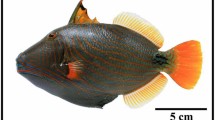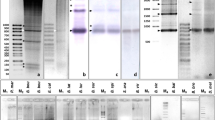Abstract
Three highly repetitive DNA components — the common cetacean component, the heavy (GC-rich) satellite and the light (AT-rich) satellite — were studied in the blue whale. Consensus sequences of the common component and the heavy satellite were determined on the basis of three repeats of the common component and eight repeats of the heavy satellite. The tandemly organized common cetacean component, which comprises a large portion of all cetacean — both odontocete (toothed whale) and mysticete (whalebone whale) — genomes has a repeat length of 1,760 bp and the three clones analysed showed a high degree of conformity. The repeat contains a 72 bp sequence with dyad symmetry and striking intrastrand complementarity. The rest of the repeat comprises a unique sequence. The repeat unit of the heavy satellite of the blue whale is 422 bp. Also this component is tandemly organized. About half the length of the repeat constitutes a unique sequence and the other half is made up of subrepeats with TTAGGG as a frequent motif. The light satellite has not been sequenced and its basic repeat unit has not yet been identified. The chromosomal localization of the three components was determined by in situ hybridization using 3H-labelled cloned fragments as probes. The common cetacean component was located in most interstitial and terminal C-bands. The heavy satellite occurred primarily in terminal C-bands. When the two components hybridized to the same terminal C-bands, the localization of the heavy satellite was distal to that of the common cetacean component. Neither component shared localization with the light satellite which is located in centromeric C-bands in just a few chromosome pairs.
Similar content being viewed by others
References
Allshire RC, Gosden JR, Cross SH, Cranston G, Rout D, Sugawara N, Szostak JW, Hastie ND (1988) Telomeric repeat from T. thermophila cross hybridizes with human telomeres. Nature 332:656–659
Árnason U (1969) The karyotype of the fin whale. Hereditas 62:273–284
Árnason U (1972) The role of chromosomal rearrangement in mammalian speciation with special reference to Cetacea and Pinnipedia. Hereditas 70:113–118
Árnason U (1974) Comparative chromosome studies in Cetacea. Hereditas 77:1–36
Árnason U (1981) Localization of nucleolar organizing regions in cetacean karyotypes. Hereditas 95:269–275
Árnason U (1982) Karyotype stability in marine mammals. Cytogenet Cell Genet 33:274–276
Árnason U (1987) The evidence for a common ancestry of toothed and baleen whales based on studies of chromosomes and highly repetitive DNA. La Kromosoma II-45:1479–1488
Árnason U, Widegren W (1984) Different raters of divergence in highly repetitive DNA of cetaceans. Hereditas 101:171–177
Árnason U, Purdom IF, Jones KW (1978) Conservation and chromosomal localization of DNA satellites in balenopterid whales. Chromosoma 66:141–159
Árnason U, Purdom IF, Jones KW (1982) Cetacean molecular hybridization using balenopterid satellite DNA cRNAs as probes. Hereditas 97:33–36
Árnason U, Höglund M, Widegren B (1984) Conservation of highly repetitive DNA in cetaceans. Chromosoma 89:238–242
Árnason U, Bellamy H, Eyporsson P, Lutley R, Sigurjonsson J, Widegren B (1985) Conventionally stained and C-banded karyotypes of a female blue whale. Hereditas 102:251–253
Árnason U, Allderdice PW, Lien J, Widegren B (1988) Highly repetitive DNA in the baleen whale genera Balaenoptera and Megaptera. J Mol Evol 27:217–221
Blackburn EH, Challoner PB (1984) Identification of a telomeric DNA sequence in Trypanosoma brucei. Cell 36:447–457
Deveraux J, Haeberli P, Smithies O (1984) A comprehensive set of sequence analysis programs for the VAX. Nucleic Acids Res 12:387–395
Duffield DA (1977) Phylokaryotypic evaluation of the Cetacea. Ph.D. Thesis, University of California Los Angeles
Galli G, Hofstetter H, Birnstiel MC (1981) Two conserved sequence blocks within eukaryotic tRNA genes are major promoter elements. Nature 294:626–631
Gomez-Marquez J, Puga A, Notkins AL (1985) Regions of the terminal repetitions of the herpes simplex virus type I genome. J Biol Chem 260:3490–3495
Macgregor HC, Sessions SK (1986) The biological significance of variation in satellite DNA and heterochromatin in newts of the genus Triturus: an evolutionary perspective. Philos Trans R Soc Lond B312:243–259
Miklos GGL (1986) Localized highly repetitive DNA sequences in vertebrate and invertebrate genomes. In: MacIntyre RJ (ed) Molecular evolutionary genetics. Plenum Press, New York and London, pp 241–321
Moyzis RK, Buckingham JM, Cram LS, Dani M, Deaven LL, Jones MD, Meyne J, Ratliff RL, Wu J-R (1988) A highly conserved repetitive DNA sequence, (TTAGGG)n, present in the telomeres of human chromosomes. Proc Natl Acad Sci USA 85:6622–6626
Rigby PWJ, Dieckmann M, Rhodes C, Berg P (1977) Labeling deoxyribonucleic acid to high specific activity in vitro by nick translation with DNA polymerase I. J Mol Biol 113:237–251
Sanger F (1981) Determination of nucleotide sequences in DNA. Science 214:1205–1210
Singh L, Purdom IF, Jones KW (1977) Effect of different denaturing agents on the detectability of specific DNA sequences of various base compositions by in situ hybridization. Chromosoma 60:377–389
Southern EM (1970) Base sequence and evolution of guinea-pig satellite. DNA. Nature 227:797–798
Southern EM (1975) Detection of specific sequences among DNA fragments separated by gel electrophoresis. J Mol Biol 98:503–517
Sumner AT (1972) A simple technique for demonstrating centromeric heterochromatin. Exp Cell Res 75:304–306
Widegren B (1986) Highly repetitive DNA in marine mammals. Ph D Thesis, University of Lund, Sweden
Widegren B, Arnason U, Akusjärvi G (1985) Characteristics of a conserved 1,579-bp highly repetitive component in the killer whale, Orcinus orca. Mol Biol Evol 2:411–419
Willard HF, Waye JS (1987) Hierarchial order in chromosome-specific human alpha satellite DNA. TIG 3:192–198
Author information
Authors and Affiliations
Rights and permissions
About this article
Cite this article
Árnason, Ú., Widegren, B. Composition and chromosomal localization of cetacean highly repetitive DNA with special reference to the blue whale, Balaenoptera musculus . Chromosoma 98, 323–329 (1989). https://doi.org/10.1007/BF00292384
Received:
Revised:
Issue Date:
DOI: https://doi.org/10.1007/BF00292384




